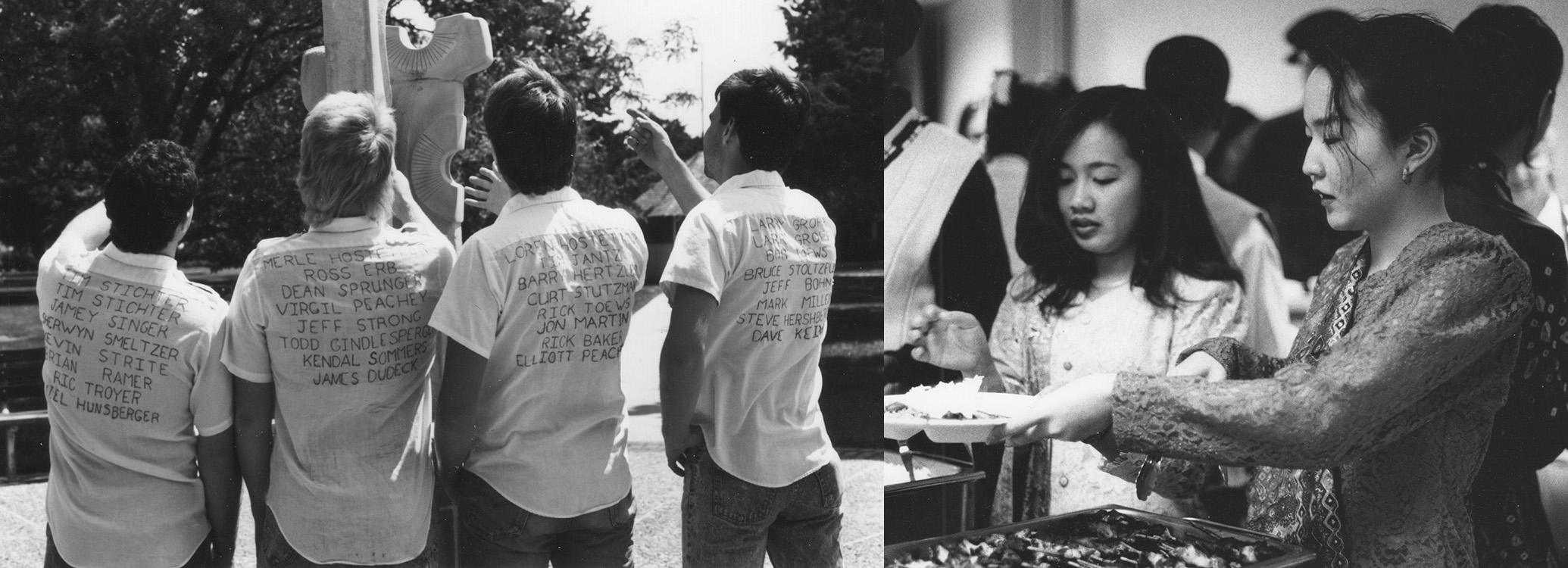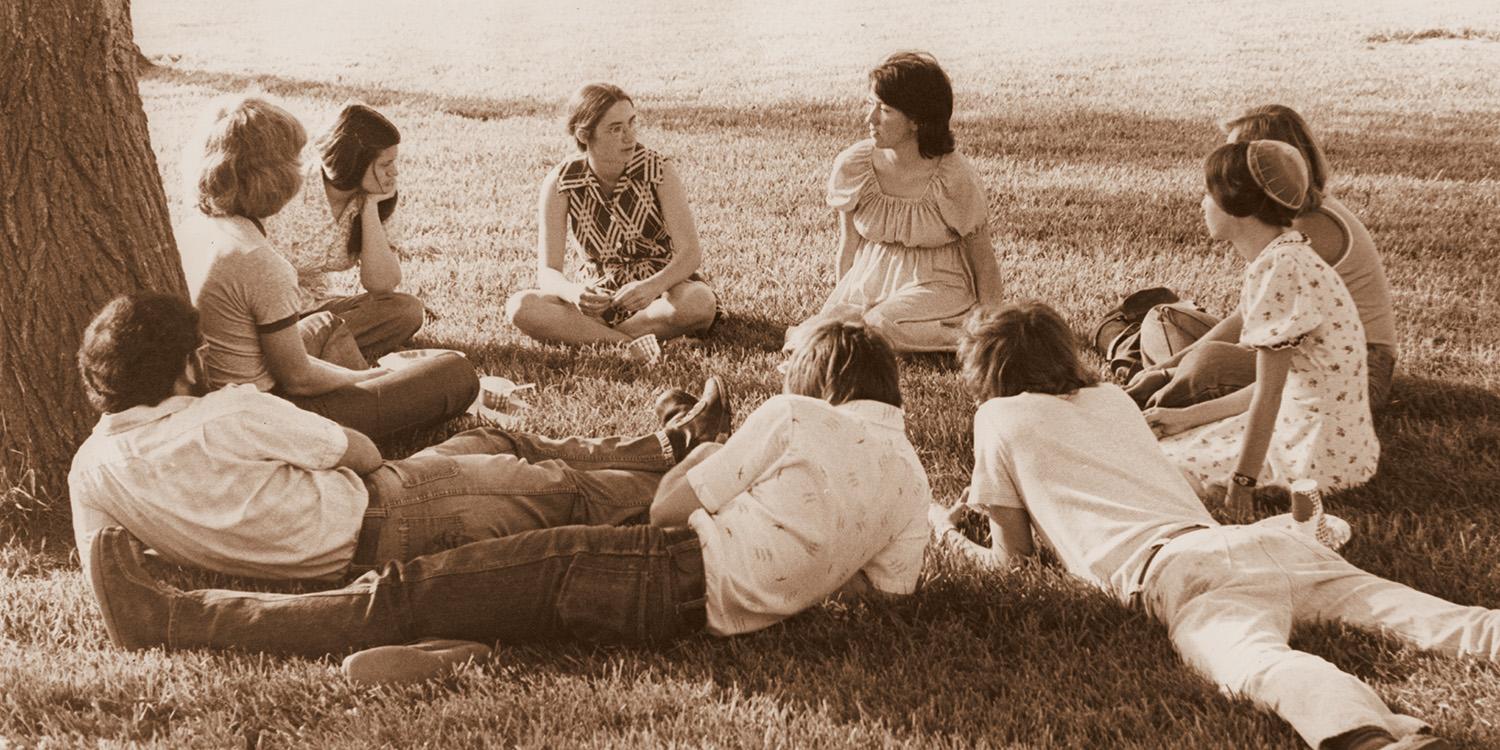Foundies class discussion group
by John Sharp ’73
The 1968 graduates said they wanted more informal interaction in the dorms, more small group sharing and more interaction during mealtimes. Outgoing President Tilman R. Smith Ac23 posed the question at his final presidential graduates’ breakfast: “What would enhance the Hesston College experience?” The sophomores, in small-group clusters, also wanted coffeehouse settings, more weekend activities and small break-out groups in large classes.
These answers helped shape the coming decades of Hesston’s academic and campus life. Unknowingly, these students expressed the ingredients of the 1960s “human potential movement,” a countercultural reaction to traditional psychological, social and religious traditions. Foundation Studies Program incorporated these elements into an innovative curriculum that my former roommate and lifelong educator Bruce Rogers ’72 called the most formative experience in his academic journey at all levels.
Although the “Foundies” liberal arts curriculum was discontinued in the spring of 1986, the highly interactive campus and academic life persisted, creating a safe and hospitable atmosphere.
Enter the Bills … and Normas!
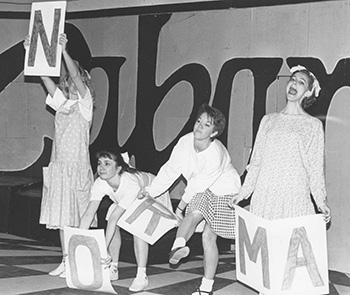
Gail (Eash) ’89 Schrock, Rhonda Miller ’89,
Judy (Clemens) ’89 Smucker and Ingrid (Rhodes) ’89 Schaedtler
He felt free to explore courses of study, switching majors three or four times. He found Foundation Studies “profound” and “brilliant” in the way it was organized and the subjects included.
“The small and confined nature of the campus required creative self-entertainment,” he remembered.
This led to the formation of the Bills in 1980. By chance, Larry Groff ’82, a friend of Hostetter, discovered four Standard Oil shirts donated to a second-hand clothing store by a former employee named Bill. As the adage goes, “The rest is history.” The shirts and the creative minds of Hostetter, Groff, Merle Hostetler ’81 and Tim Stichter ’82 launched a decades-long entertainment squad. Milking the positive response to their imaginative chapel announcements, they performed light-hearted impromptu acts in other social settings on campus such as informal coffeehouse venues.
On a more serious level, Hostetter also thrived in music-making opportunities.
“Singing in Randy Zercher’s (’61 music professor) choir took my music to another level,” he said and added that it provided “endless interactive bonding on week-long choir tours.”
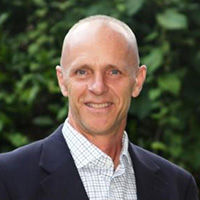
The Bills continued to bring fun and entertainment to campus in the coming years, with the outgoing Bills selecting their replacements for the next year. Female students were then added to the spotlight when the Normas joined the fun in the late ’80s.
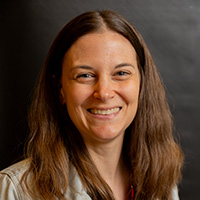
“I was invited to become a Norma even though I thought the other Bills and Normas were much funnier than I was,” she admits. “A background in theatre gave me an on-stage experience, but I needed a script! No one handed me one, so we created our own. We began using video, which meant planning, staging and finding students with expertise in shooting and editing. Video became an important medium for creating content we thought would be funny for our peers!”
Looking back on her time at Hesston, Gipson is grateful for all she gleaned from the experience, not just what she poured out as a Norma.
“Hesston was the perfect place for me as an 18-year-old to figure out who I was and how to become an adult,” she says. “I felt safe, affirmed and appreciated by students and faculty. This affirmation is something I carry with me, and I now use it in my work with students as the associate director of financial aid at Hesston College. I want them to feel safe and appreciated the same way I did!”
Bel Canto Singers became her primary learning and social interaction group.
“Choir tours were significant events that helped shape my Hesston experience,” she recalls. “I met many new people in the churches that hosted us, which enlarged my horizons! Bradley Kauffman (music professor) influenced me in so many ways. He was able to take a bunch of 18-year-olds and churn out a choir that sounded like adults!”
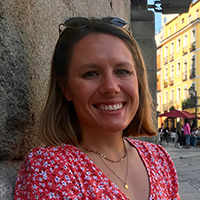
She was surprised to be invited to be a Norma coming as it did in a 2 a.m. phone call. She didn’t think of herself as funny but loved bringing a sense of fun, lightness and joy to campus amid hard academic work.
Wyse felt at home at Hesston, but at the same time, her horizons were stretched.
“My worldview was challenged,” she shares. “For the first time, I looked beyond myself, my circle of friends, family and previous experiences.”
Cultural diversity
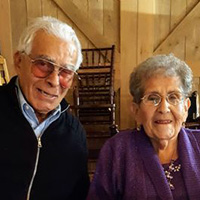
Juan “John” Ventura Ac45 ’49, originally of Chicago, Ill., said the college has been spiritually and academically foundational for his family. Despite racial discrimination — he and his brother were placed in segregated housing, and the uptown barber refused to cut his hair — his Hesston experience was transformational.
“We had a good time, yeah, and we were very naked when we got there,” Ventura shared.
He went on to explain, “We bought a trunk and suitcases and they all got lost, so there we were at Hesston in the same clothes for about a month and being very conscious that we were Mexicans — we were dirty Mexicans.”
Thankfully, it was not a sentiment felt by everyone they encountered.
“There were people from all over, and they came and brought us food, they brought us clothing, they brought us kindness,” Ventura said. “So even though we experienced these individual harsh discriminations, other Mennonites took care of us.”
He loved and respected the teaching and example of faculty members like D.D. Driver Ac16 1923 and former President Milo Kauffman Ac22 1926. Having experienced financial uncertainty in early life, he noticed and appreciated the sacrifices of faculty and staff when they could have earned more money elsewhere. In gratitude, Ventura and his wife Hope have established the Ventura Family Scholarship fund to help today’s students.
In establishing the fund, Ventura recognized the lifelong friendships of Esther Rose (Buckwalter) Ac48 ’50 Graber, Lester Hershey, Don Driver Ac47 ’49 and the Kathryn (Miller) 1923 and Paul Ac16 1924 Snyder family. After all, the friends we make define the core of the Hesston Experience.
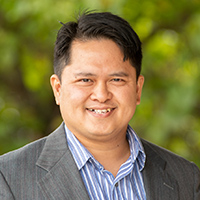
“He was a huge part of my life journey; I owe him everything,” Gunawan said. “Dave was patient as I was learning better English and navigating American culture. It was all new to me.”
Gunawan had never seen snow or felt cold weather. The close-knit community helped him adjust.
“I was learning to be an adult in this new territory. I was making the transition to adulthood,” he shared, adding that the small friendly campus, knowing teachers by name and having a great roommate helped.
He earned money by washing dishes in the cafeteria and doing maintenance work. When he needed to go shopping, Osborne took him.
After graduating, Gunawan attended Tabor College in the nearby town of Hillsboro, Kan., where he earned his bachelor’s degree. While there, he often came back to Hesston to interact with friends. At such a gathering, he met his future wife Chika Sunoto ’04, who was from, of all places, Indonesia! His home was Pati, and she lived in Semarang. They met at Hesston in 2002, married in 2007 and now have three children: Matthew, 14; Caleb, 12; and Maura, 7.
“You know, it’s true what they say, ‘Start here, go everywhere.’ Hesston is where my world began,” Gunawan said.
He started at Hesston, earned a master’s degree in finance at Indiana University and now is senior executive of operations for Mennonite Mission Network.
“I’m very grateful for my Hesston experience,” he said.
Of course, anyone who attended or worked at Hesston from its beginning in 1909 has had a “Hesston Experience,” but the phrase seems to have gained new currency with President Smith’s question to graduates in 1968. And now, it is a stock phrase to describe a certain positive vibe on campus. Given the stories above, it’s safe to say the Hesston Experience is a thing long-remembered.
